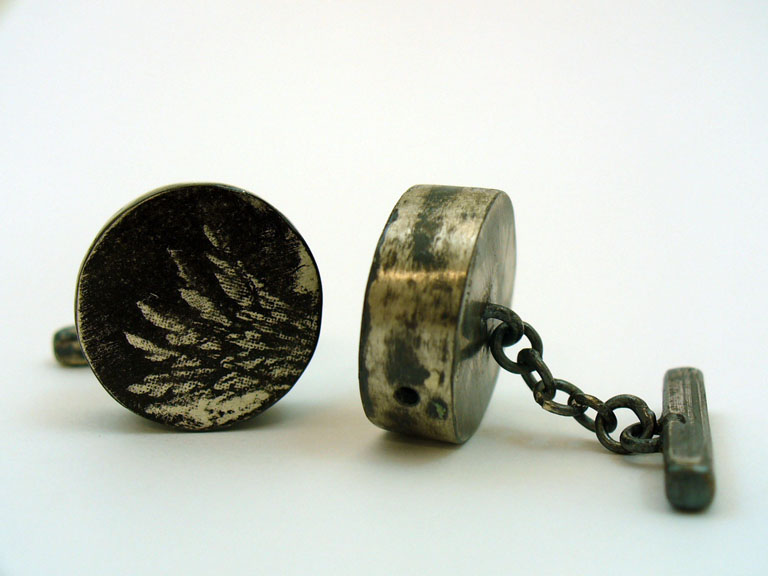

Title: Memento Mori Cuff Links
Shipping: $10.00
Artist: N/A
Period: Contemporary
History: N/A
Origin: N/A
Condition: Excellent
Item Date: March 2009
Item ID: 1962
Caroline Bassett Sterling Silver Winged Memento Mori pattern Cuff Links. Round, 3 dimensional, imagery illustration, printed silver 925. Links, hollow form, fabrication, fob chain, blackened silver. Jewellery, jewelery, Romanticism of Mourning jewelery, Modern Jewellery, Design, Handmade, New Zealand, Object, Adornment, Mens Jewelery,
Link: http://www.answers.com/topic/jewelry#Form_and_function
Romanticism Jewellery
Starting in the late 18th century, Romanticism had a profound impact on the development of Western jewellery. Perhaps the most significant influences were the public’s fascination with the treasures being discovered through the birth of modern archaeology, and the fascination with Medieval and Renaissance art. Changing social conditions and the onset of the industrial revolution also lead to the growth of a middle class that wanted and could afford jewellery. As a result, the use of industrial processes, cheaper alloys, and stone substitutes, led to the development of paste or costume jewellery. Distinguished goldsmiths continued to flourish, however, as wealthier patrons sought to ensure that what they wore still stood apart from the jewellery of the masses, not only through use of precious metals and stones but also though superior artistic and technical work; one such artist was the French goldsmith Françoise Désire Fromment Meurice. A category unique to this period and quite appropriate to the philosophy of romanticism was mourning jewellery. It originated in England, where Queen Victoria was often seen wearing jet jewellery after the death of Prince Albert; and allowed the wearer to continue wearing jewellery while expressing a state of mourning at the death of a loved one.
Modern Jewellery
Reversible pendant mimics the constellations representing a star map of the zodiac signs.
The modern jewellery movement began in the late 1940s at the end of World War II, with a renewed interest in artistic and leisurely pursuits. The movement is most noted with works by Georg Jensen and other jewellery designers who advanced the concept of wearable art. The advent of new materials, such as plastics, Precious Metal Clay (PMC), and colouring techniques has led to increased variety in styles.
The "jewellery as art" movement was spearheaded by artisans such as Robert Lee Morris and continued by designers such as Anoush Waddington in the UK. Influence from other cultural forms is also evident; one example of this is bling-bling style jewellery, popularized by hip-hop and rap artists in the early 21st century.
The late 20th century saw the blending of European design with oriental techniques such as Mokume-gane. The following are innovations in the decades stradling the year 2000: "Mokume-gane, hydraulic die forming, anti-clastic raising, fold-forming, reactive metal anodizing, shell forms, PMC, photoetching, and [use of] CAD/CAM."